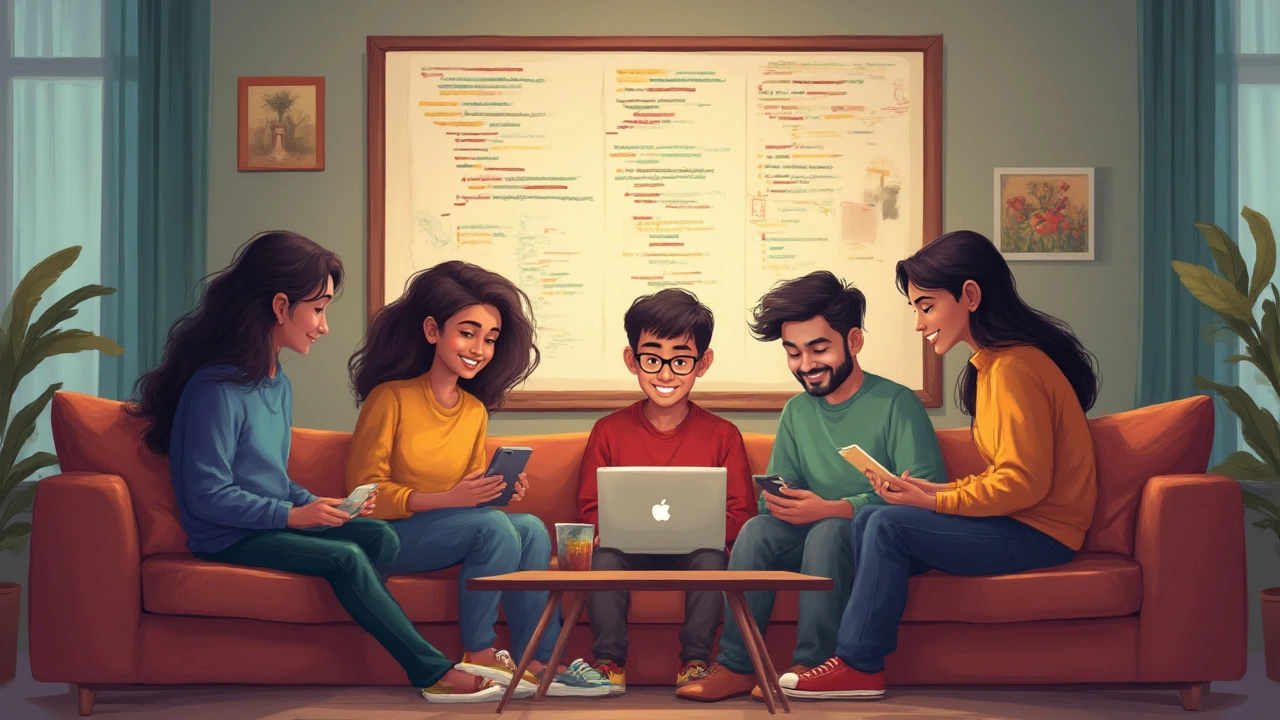You might think learning to code requires expensive degrees or years under strict teachers. That's a total myth. Every year, thousands of regular folks become self-taught coders, landing new jobs and building stuff from scratch without ever stepping into a classroom. Even the founders of some famous tech companies—guys like Jack Dorsey and Mark Zuckerberg—started by teaching themselves. If you feel stuck or lost at the thought of programming, you’re definitely not alone. A Stack Overflow survey in late 2024 found nearly 72% of professional developers said they were at least partially self-taught. The secret isn’t in the perfect book or tutorial—it’s in your method, your mindset, and your willingness to tinker, fail, and try again. Coding is problem-solving, not magic.
Why Learning to Code on Your Own Works
There’s a weird freedom in teaching yourself something as powerful as programming. You set your schedule, pick your projects, and work at your own pace. No bells ringing after forty minutes. Self-taught coders often get hired because they’ve already figured out how to learn new things by themselves—an insanely useful skill in tech. Companies want people who can find answers, try new tools, and adopt changes fast. Most coders you admire weren’t computer science majors from fancy colleges; they were curious, hungry to solve problems, and willing to learn from mistakes.
Why has this do-it-yourself approach gotten so popular? For starters, credible resources have exploded online. Back in 2010, you’d struggle to find decent tutorials unless you bought thick textbooks. But now, places like freeCodeCamp, Codecademy, The Odin Project, and even YouTube channels have everything from real basics to advanced stuff explained in plain English, often for free. People aren’t just coding for IT jobs anymore. Artists, doctors, marketers—every profession wants to understand a bit of code. You don’t need to chase massive knowledge. Instead, it’s about learning just enough to tackle your current project, then building up from there. This piecemeal, practical learning can keep you from getting overwhelmed and quitting early.
Let’s bust another myth: you’re not too old or too "non-technical" to learn. Research by LinkedIn in 2023 showed people switching to tech careers at every age, with more than 35% of coding bootcamp students being over 35. Your brain can adapt. Adults learn differently from kids, but you’re way more persistent—and you know how to ask better questions. Instead of memorizing syntax, focus on building tiny projects that interest you. Fix something real in your life or automate boring jobs. This gives your learning a purpose and sticks in your head way better than just reading manuals.
Choosing the Right Languages and Tools
This is where a lot of beginners get overwhelmed. Should you start with Python, JavaScript, C++, or something else? Here’s the deal: pick one language and stick with it until you’re comfortable with the basics. Don’t try to learn five at once. For most beginners looking to build apps, websites, or automate things, Python or JavaScript are safe bets. Python is beloved by folks doing data science, automation, and AI (and it reads almost like English). JavaScript rules the web and can help you build interactive sites quickly. But remember, languages are just tools—once you know one, picking up another isn’t as hard as it looks.
To give you a concrete idea, here are a few beginner-friendly languages and why people pick them:
- Python: Super readable, tons of free resources, used in web development, data analysis, AI, and automation.
- JavaScript: Controls everything on websites; easy to try out in your browser immediately; must-have for web devs.
- Scratch: Visual, drag-and-drop code for kids and complete newbies; great for learning logic.
- Ruby: Friendly syntax, popular for small web applications.
- Java: Used for Android apps and big company projects; more rules, but lots of jobs.
Once you have your language, you’ll need a text editor—VS Code is an industry favorite and it’s free. Set up your editor and learn how to run code snippets. Don’t drown in fancy extras: stick to basic features like syntax highlighting and error messages in the beginning. Tackling tool setup early helps you get used to things you’ll actually use later in real-world work.

Building Your Learning Roadmap
Randomly hopping between tutorials can fry your brain. The people who actually stick with coding are the ones who make a plan, even if it’s basic. Want to automate spreadsheets at work? Build a personal budget app? Make a game? Let your goal guide each step. Here’s a simple starter roadmap for someone teaching themselves to code:
- Basics: Learn how to print messages, handle variables, do basic math, and understand data types.
- Logic: Grasp how to use if-statements, loops, and functions to control your code’s flow.
- Structures: Start using lists, dictionaries, or arrays to organize bigger globs of data.
- Projects: Choose tiny projects. Maybe a calculator, a to-do list, or a weather app using an API.
- Debugging: Learn to read error messages. Try fixing mistakes before you look at someone else’s code.
- Refine: Read other people’s code on sites like GitHub. See how pros write and organize big projects.
- Keep Going: Add new challenges. Get into APIs, databases, or web frameworks when you’re ready.
If you want accountability, join a community. Reddit, Discord groups, or even Twitter (now called X) offer places to ask questions and share progress. According to a 2024 Stack Exchange poll, coders in active communities were 60% more likely to finish personal coding projects. Learning alone doesn’t mean being lonely—you’ll get stuck less and celebrate more this way.
Making the Most of Free and Paid Resources
When you Google "learn to code," the flood of results can feel like standing under a waterfall. Here’s a quick table comparing some of the most popular learning platforms as of 2025:
| Platform | Free? | Best For | Notable Features |
|---|---|---|---|
| freeCodeCamp | Yes | Beginners to advanced | 10,000+ lessons, real projects |
| Codecademy | Partly | Absolute beginners | Instant code feedback |
| The Odin Project | Yes | Web development | Full curriculum, real-world projects |
| Udemy | No (Paid) | All levels | In-depth video courses, affordable |
| Coursera | Some free courses | All levels | University instructors, certificates |
| YouTube | Yes | Quick lessons | Massive variety, real-time walk-throughs |
Don’t get tricked into paying for expensive bootcamps right away. Free resources can get you surprisingly far—many new coders land internships and freelance gigs on freeCodeCamp projects alone. Try a few different teaching styles. Podcasts and video walkthroughs help when you’re tired of reading. If you need extra push and structure, a paid course or a coding bootcamp can be worth it, but look for strong reviews and job placement data.
Mix your learning: read documentation, build stuff, and get feedback from real people. Don’t worry if you struggle with concepts like object-oriented programming or recursion at first—most learners hit plateaus. It’s completely normal to get stuck. When that happens, write down your roadblock, step away, and return with fresh eyes. You’ll be amazed how problems pop clearer after a break.

Staying Motivated and Avoiding Burnout
Here’s the truth: most people give up on learning to code not because they’re bad at it but because they expect everything too fast. Coding isn’t a race. Expect mistakes. Expect moments when nothing makes sense. That’s usually when a lightbulb is about to switch on. The trick isn’t dramatic willpower—it’s tiny wins. Celebrate cracking your first bug or making your program print “Hello, World!” without help. Build the habit with bite-sized daily practice. Think 30-40 minutes a day can’t add up? Results from a 2023 Coursera learner study showed those practicing under one hour daily stuck with coding nearly six times longer than those who crammed for full weekends.
Find motivation by tracking your progress. Keep a log, post projects online, or share updates with friends. Try programming puzzles or sites like LeetCode and Codewars—gamifying helps break the monotony and makes learning fun. Stay away from giant, intimidating projects early on. Stick to problems you find a little challenging but still doable. As you gain confidence, ramp up the difficulty. Challenge yourself to automate something annoying at work or in daily life—a simple bill tracker, for example, or a photo filter using Python. Real-life rewards keep you moving.
Remind yourself: you don’t have to know everything. Even people with years of experience still Google every day. The world of code is too big to master all at once. Make mistakes, ask dumb questions (there aren’t any), and document what you learn as you go. Treat each wrong turn as a stepping stone, not a failure. People who stick with this mindset eventually get good—slow and steady actually works.
People say learning to code is like learning a foreign language, but really, it’s more like learning to cook. You won’t make a gourmet dish on day one—you’ll burn a few things, have some tasteless meals, and gradually learn what works. Don’t worry about embarrassing mistakes; everyone starts as a newbie. When you finally see your code come to life or land your first freelance gig, those frustrating moments will make the win feel that much sweeter. So, start with a small project, celebrate every glitch you fix, and trust that each session brings you one step closer to mastering the skill.
